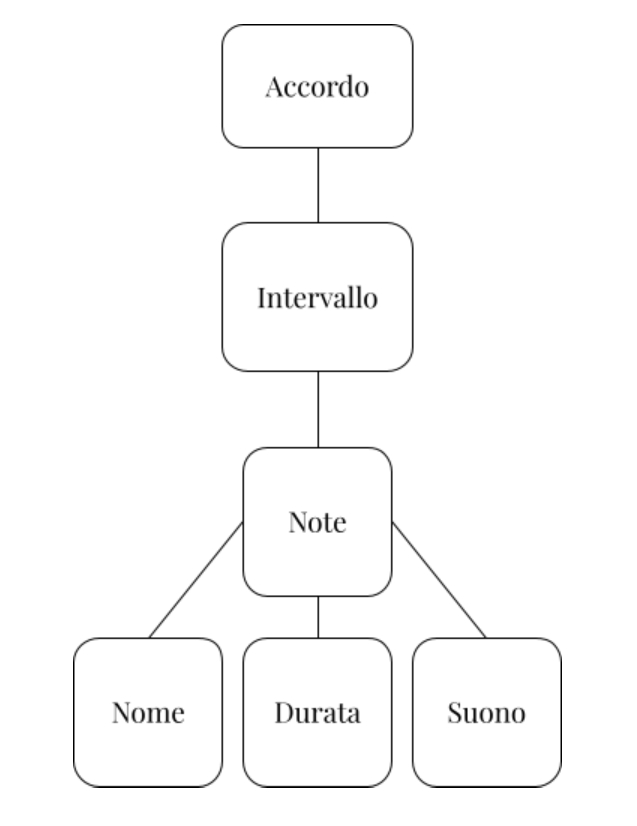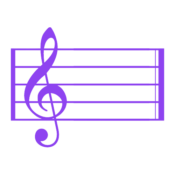Introduction
We had left, in the last article, with a quote from Harmony by Walter Piston in which the author related chords and intervals, implicitly introducing us to the triad chord: you can buy the manual we talked about to deepen the contents of this article, piano chords, triads and more complex harmonic concepts, at the link below:
We had also said that a beginner of piano reading is recognized by the fact that he will tend to read one note at a time: not knowing from a practical point of view concepts broader than that of note, his musical eye will be very slow. To start speeding it up we had introduced the interval, which is a broader concept than that of note as they contain at least two notes.
The Techniques of Piano Reading Method
With this article we improve your reading by taking it a step further and starting from a simple concept map. Read it this way: chords contain intervals, which in turn contain notes, which in turn contain names, durations, and sounds. Here it is below:

The Triads
The intervals we use to build triads, and to tell the truth almost any agreement that we will deal with beyond a triad, are the third. Depending on the number of third parties that we are going to overlap, the agreement will take on a different generic name. The triad is defined when the thirds overlap are two. In other words, since you cannot overlap less than two thirds, the triad is from a point of view intersperse the smallest type of chord that can be found in tonal music. Tonal music also refers to the kind of musical conception that underlies the canonical elementary exercises for the piano, such as Czerny, Beyer, Duvernoy, Cramer… And many more. There are so many of them. If you're not sure which one to start from, I recommend buying these two first:
You will find that we will often name them in the course of our articles. But let's go back to today's topic: we were saying that the overlapping of two thirds, gives rise to a triad agreement.
The Intervals: Harmonics VS Melodic
As you see a triad is formed by only harmonic intervals: being composed of rhythmically simultaneous elements, these are written vertically one above the other; the reading of this type of interval i will therefore be vertical: at first, for harmonic reasons, I advise you to always read it from the bottom up. The melodic intervals are instead composed of elements that follow one another and that are therefore written next to each other: the reading of this type of interval will therefore be horizontal (from left to right).
Vertical Reading VS Horizontal Reading
It is essential that you know that vertical and horizontal reading are one in music, but above all that, in most cases, what is written horizontally can be read vertically. Take for example an arpeggio, which is simply a chord whose notes are performed one after the other, non-simultaneously:
In this case reading the notes taken individually is useless, reading them horizontally even less. To identify at a glance that the six notes written above are a triad repeated twice you must know how to look at the numerical aspect of the pentagram, that is, know how to read vertically the generic names of the intervals. The three names of note that make up the first arpeggio are in fact all written on the lines. The distance between one note name and another is not as large as that of a fifth, nor as small as that of a second, also because in the latter case, being an even interval , the note names would not all be written on the lines, but in a different way: some on the lines and some on the spaces. From you can conclude that, if you had not been able to distinguish this "type of word" of music, that is, the chord and therefore the arpeggio, you could not have grasped the most appropriate methodology to read the passage in example. To sum up, you can trace the melodic intervals you have identified to harmonic intervals , and then to the starting triad:
That's why I told you that the horizontal and vertical components are constantly taken by the hand in reading a score.
Things not to do
I advise you not to experiment with the techniques that I propose on scores that are too complex, or you will only end up discouraging yourself unnecessarily. The manuals that I have attached above are the most suitable to start practicing, I report them below:
Concusions
To learn to read a language that you do not know, you usually start from simple sentences: the same happens in Music, through the gradual correlation of simple concepts to increasingly complex sets that contain them. If you want to learn more about the topic, subscribe to our newsletter to receive a notification when a new article will be published!
- History Of The Piano – The Fortepiano - July 12, 2022
- Curt Sachs – History Of Organology At a Glance - July 8, 2022
- Giuseppe Verdi – Rigoletto, Il Trovatore, La Traviata - June 29, 2022
